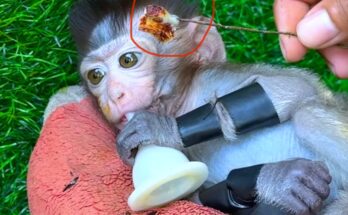.Dermatitis, a general term for skin inflammation, is not exclusive to humans—it also affects non-human primates, including young monkeys. In captive and wild populations alike, skin issues in juvenile monkeys can signal deeper health concerns or environmental problems. Addressing dermatitis in young monkeys is essential for their well-being, development, and longevity.
Common Causes of Dermatitis in Young Monkeys
Young monkeys are particularly vulnerable to dermatitis due to their developing immune systems and higher sensitivity to environmental factors. The most common causes include:
- Allergic Reactions: Just like in humans, young monkeys may suffer from allergic dermatitis caused by bedding materials, cleaning agents, food, or even pollen and dust in the environment.
- Parasites: Mites, fleas, and lice are common culprits of skin irritation. Infestation often results in itching, scratching, hair loss, and secondary infections.
- Poor Hygiene: Inadequate sanitation in enclosures or nests can expose young monkeys to bacterial or fungal pathogens, leading to conditions like seborrheic or contact dermatitis.
- Nutritional Deficiencies: Deficiencies in essential fatty acids, vitamins A, E, and zinc can lead to dry, flaky, or inflamed skin. This is especially a concern in captive environments where diet is not closely monitored.
- Stress-Related Behavior: Social stress, maternal separation, or inadequate enrichment can lead to excessive grooming or self-scratching, which damages the skin over time.
Symptoms to Watch For
Identifying dermatitis early helps prevent complications. Caretakers and researchers should be on the lookout for:
- Redness or swelling of the skin
- Patches of hair loss
- Persistent scratching or grooming
- Sores, scabs, or oozing lesions
- Flaky, crusty, or excessively dry skin
Behavioral changes such as irritability, lethargy, or social withdrawal can also signal discomfort due to skin issues.
Prevention Strategies
Preventing dermatitis in young monkeys involves a combination of hygiene, nutrition, veterinary care, and proper environmental management.
- Clean Living Conditions: Regular cleaning of enclosures, removal of waste, and use of non-irritating cleaning products reduce exposure to allergens and pathogens.
- Balanced Nutrition: Providing a varied, species-appropriate diet rich in essential nutrients helps maintain healthy skin and fur. Supplements may be necessary in captivity.
- Regular Health Monitoring: Frequent veterinary check-ups and parasite control programs (e.g., deworming and external parasite treatments) are vital, especially in breeding or research facilities.
- Environmental Enrichment: Social interaction, mental stimulation, and physical activity reduce stress-induced grooming behaviors that can lead to dermatitis.
- Early Intervention: At the first signs of skin problems, immediate veterinary consultation can prevent the spread or worsening of dermatitis.
Conclusion
While dermatitis in young monkeys may appear to be a minor issue, it can signal deeper systemic or environmental problems. A proactive approach—focusing on prevention, early detection, and comprehensive care—ensures these intelligent and sensitive animals grow up healthy and thrive in their environments. Whether in conservation, research, or sanctuary settings, addressing skin health is an essential aspect of responsible monkey care.
.



